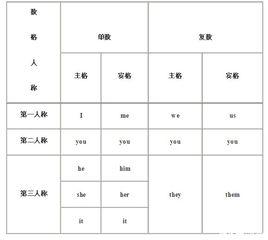人稱代詞的主格與賓語
人稱代詞有主格和賓格兩種形式,第三人稱的人稱代詞還有性別的變化。主格主要用來做句子的主語,在正式文體中也可用作表語;賓格主要用作賓語,在口語中也常用來做句子的表語。在口語中,若省略謂語及其他成分的短句中,人稱代詞賓格可用作主語 。如:
“He has read the novel. ” “Me too. ” “他看過這小說”。“我也看過”。
人稱代詞的排列順序
1. 兩個或兩個以上的人稱代詞並列使用時,對於單數人稱代詞,按“二三一”的順序排列;對於複數人稱代詞,按“一二三”的順序排列。如:
You, he and I must obey the rules. 你,他和我都得遵守規則。
We, you and they should stay here. 我們,你們和他們都應該留在這。
2. 若要承擔責任或過失時,則通常將第一人稱放在前面。如:
It was I and Tom who were late. 遲到的是我和湯姆。
3.表示男女的代詞並排使用時,通常是先男後女。如:
Nobody likes such things except him and her. 除了他和她,沒有喜歡那樣的東西。
人稱代詞使用賓格的五點注意
1. 會話中,在be後作表語用賓格不用主格。如:
—Who is it?
—It’s me / him.
—誰?
—是我 / 他呀。
2. 在單獨使用或帶not的簡略回答中用賓格不用主格。如:
—Who wants a ride on my bike?
—Me! (Not me!)
—誰想騎我的腳踏車?
—我!(不是我!)
—I like swimming.
—Me too.
—我喜歡游泳。
—我也是。
3. 在感嘆疑問句中做主語,以引起強調。如:
—You can tell him.
—Me tell him? Not likely!
—你可以告訴他。
—我告訴他?不可能!
—Susan, go and join your sister cleaning the yard.
—Why ________ ? John is sitting there doing nothing. (全國卷)
A. him B. he C. I D. me
【分析】答案選D。
4. 在as或than後,若沒帶有動詞時,多用賓格。如:
I am as tall as him. 我和他一樣高。
I am taller than him. 我比他高。
5. 在下列之類的祈使句中。如:
He’s got to repay the money—poor him. 他得償還這筆錢——可憐的他呀!
使用人稱代詞的幾個注意點
1. 指代國家、城市、地球、船舶、(雌性)動物等時,一般用代詞 it,但也可用she / her(帶感情色彩) 。如:
My car’s not fast, but she does 50 miles to the gallon. 我的車不快,但每加侖油它能跑50英里。
2. 當上文提到的人的性別不明時,一般用 he / him 來指代。如:
Whoever told you that, he was lying. 無論誰對你那樣說,他都在說謊。
If a person had so much money, he would do it in another way. 要是一個人有那么多錢,他就會用另外一種方法做這事。
說明:
對於 anybody, everybody, nobody, anyone, someone, everyone, no one 這類性別不明的不定代詞,它們可用單數 he, him 指代,也可用複數 they, them指代,用單數較正式,用複數較口語化。如:
If anybody [anyone] comes, ask him [them] to wait. 要是有人來,讓他等著。
3. 代詞we, you, they 有時可用於泛指一般人。如:
We [You] ought to obey the law. 大家都應遵守法律。

